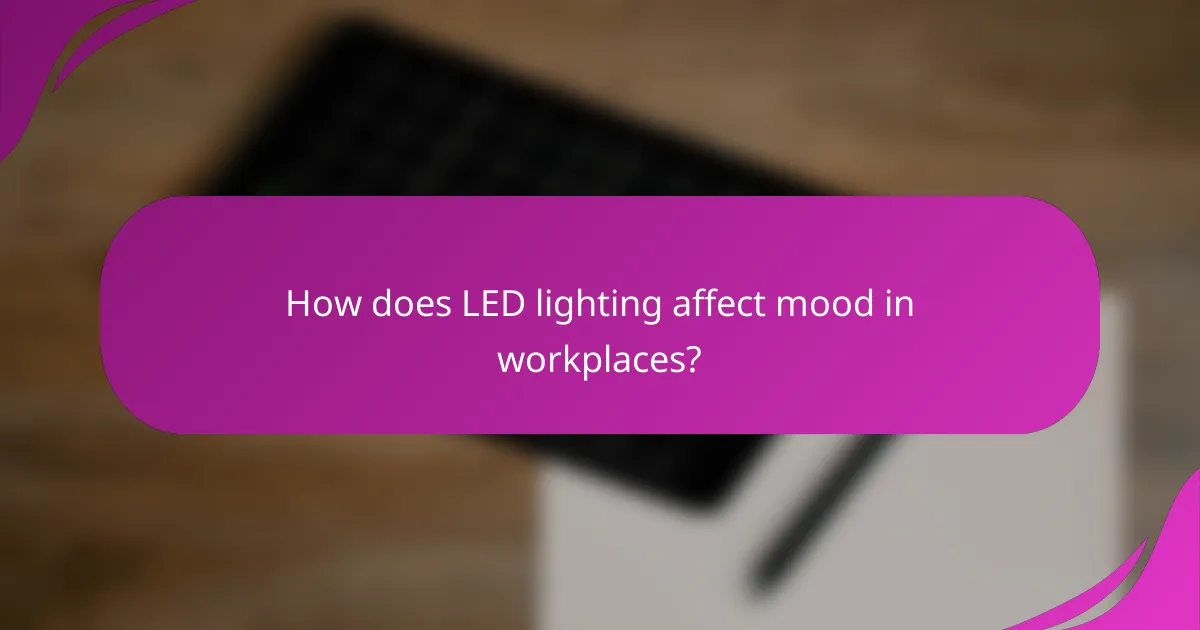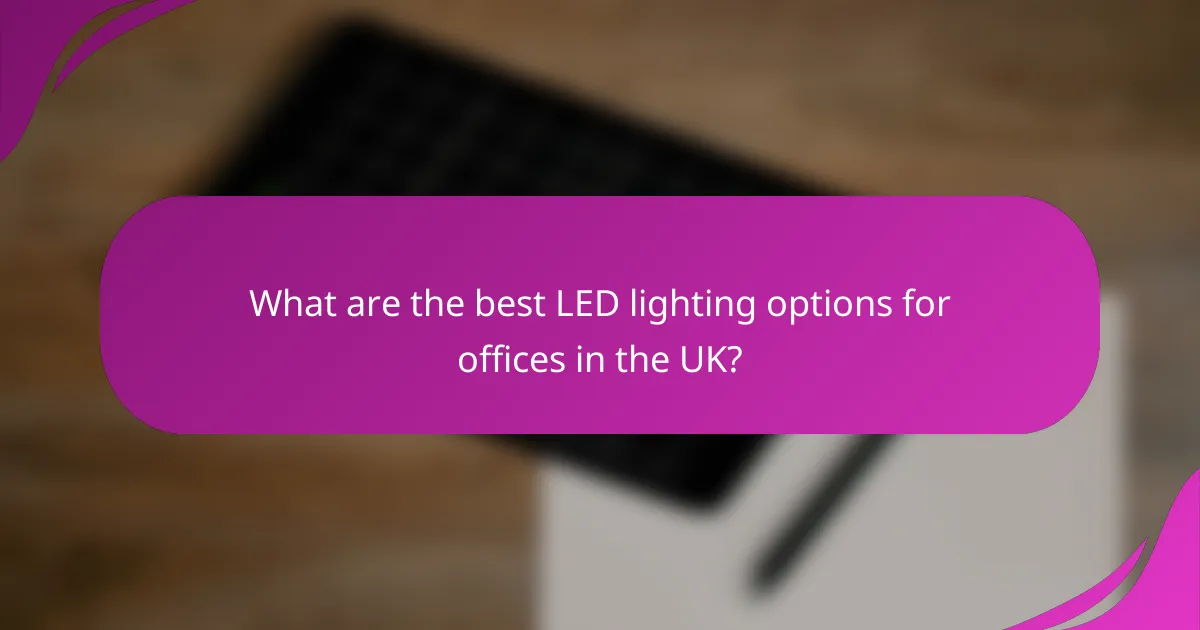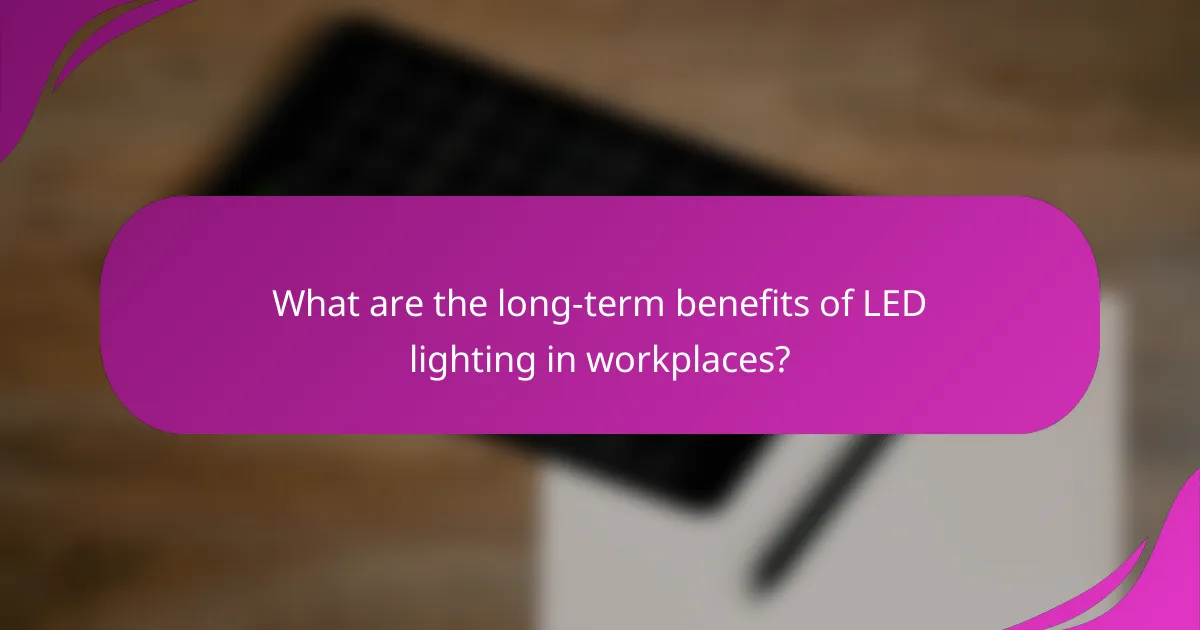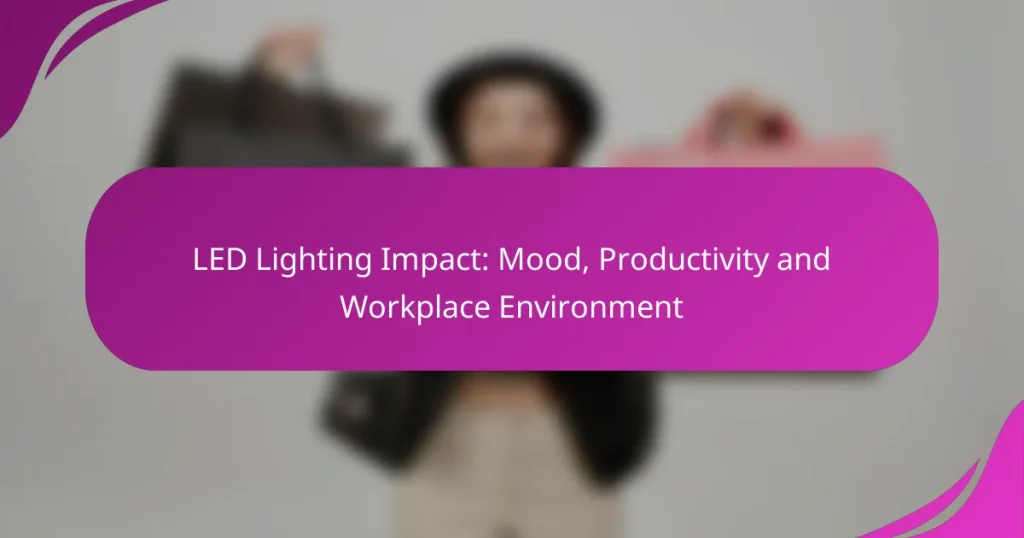LED lighting plays a crucial role in shaping workplace environments by enhancing mood, productivity, and overall well-being. By mimicking natural light, it creates a more pleasant atmosphere that boosts emotional health and focus among employees. Additionally, its energy efficiency contributes to a sustainable work environment, further promoting satisfaction and performance.

How does LED lighting affect mood in workplaces?
LED lighting significantly influences mood in workplaces by creating a more pleasant and stimulating environment. Its ability to mimic natural light can enhance emotional well-being and productivity among employees.
Enhances focus and concentration
LED lighting can improve focus and concentration by providing bright, clear illumination that reduces eye strain. This type of lighting helps maintain alertness, especially in environments where tasks require prolonged attention.
To maximize focus, consider using adjustable LED fixtures that allow employees to control brightness levels according to their preferences. A well-lit workspace can lead to increased efficiency and reduced errors in task completion.
Reduces stress and anxiety
Properly designed LED lighting can help lower stress and anxiety levels in the workplace. Soft, warm LED lights can create a calming atmosphere, which is essential in high-pressure environments.
Employers should aim to balance bright task lighting with softer ambient lighting to create a more relaxed setting. Incorporating natural light where possible also contributes to a sense of well-being and reduces feelings of confinement.
Improves overall well-being
LED lighting positively impacts overall well-being by promoting a healthier work environment. Exposure to appropriate light levels can regulate circadian rhythms, leading to better sleep patterns and increased energy during working hours.
To foster well-being, organizations should consider implementing dynamic lighting solutions that adjust throughout the day. This approach can help align the lighting with natural daylight cycles, enhancing mood and productivity while reducing fatigue.

What is the impact of LED lighting on productivity?
LED lighting significantly enhances productivity by improving visibility and creating a more conducive work environment. Its energy efficiency and ability to mimic natural light contribute to better focus and overall task performance.
Increases task performance
LED lighting can lead to higher task performance by providing consistent and bright illumination. Studies show that well-lit environments reduce errors and increase the speed of completing tasks, especially in detail-oriented jobs.
For example, in office settings, using LED lights can enhance reading and writing efficiency, allowing employees to complete their work more quickly and accurately. Ensuring adequate light levels can be crucial in achieving optimal performance.
Boosts energy levels
Exposure to LED lighting can help boost energy levels throughout the workday. The bright, white light emitted by LEDs closely resembles natural daylight, which can help regulate circadian rhythms and reduce feelings of fatigue.
Incorporating LED lighting into workplaces can lead to a more vibrant atmosphere, encouraging employees to stay alert and engaged. Simple adjustments, such as increasing light intensity during peak hours, can further enhance energy levels.
Facilitates better decision-making
Good lighting, particularly from LEDs, can facilitate better decision-making by improving mood and cognitive function. Bright, well-distributed light helps reduce eye strain and enhances clarity of thought, which is essential for critical thinking tasks.
In environments where important decisions are made, such as conference rooms or collaborative spaces, using LED lighting can create a more inviting atmosphere, encouraging open communication and effective brainstorming sessions.

How can LED lighting improve workplace environments?
LED lighting can significantly enhance workplace environments by creating a more pleasant atmosphere, improving visual comfort, and promoting sustainability. These benefits contribute to increased employee satisfaction and productivity.
Creates a more inviting atmosphere
LED lighting can transform a dull workspace into a vibrant one, making it more inviting for employees and visitors. By using warm white or adjustable color temperatures, businesses can tailor the lighting to match the desired mood, fostering a friendly and welcoming environment.
For example, using softer lighting in break areas can encourage relaxation, while brighter, cooler lighting in workspaces can enhance focus and energy. The right LED fixtures can also highlight architectural features, making the overall space feel more engaging.
Enhances visual comfort
Visual comfort is crucial for maintaining productivity and reducing eye strain. LED lighting provides consistent illumination without flickering, which can be a common issue with traditional fluorescent lights. This stability helps employees focus better on their tasks.
Additionally, LEDs can be designed to minimize glare and provide a more even distribution of light. Choosing fixtures with diffusers or indirect lighting options can further enhance visual comfort, making the workspace more conducive to long hours of work.
Supports sustainable practices
LED lighting is an eco-friendly choice that supports sustainable practices in the workplace. These lights consume significantly less energy compared to traditional bulbs, leading to lower electricity bills and reduced carbon footprints.
Moreover, LEDs have a longer lifespan, which means fewer replacements and less waste. Companies can also benefit from government incentives or rebates for upgrading to energy-efficient lighting systems, making it a financially sound investment.

What are the best LED lighting options for offices in the UK?
The best LED lighting options for offices in the UK include smart LED bulbs, adjustable color temperature fixtures, and energy-efficient panel lights. These options enhance workplace productivity and mood while being energy-efficient and cost-effective.
Smart LED bulbs
Smart LED bulbs are versatile lighting solutions that can be controlled remotely via apps or voice assistants. They allow users to adjust brightness and color, creating an environment that can be tailored to different tasks or moods.
When selecting smart bulbs, consider compatibility with existing fixtures and the ability to integrate with smart home systems. Popular brands in the UK include Philips Hue and LIFX, which offer a range of features and price points.
Adjustable color temperature fixtures
Adjustable color temperature fixtures allow users to change the light’s warmth, ranging from cool white to warm yellow. This flexibility can help mimic natural daylight, which is beneficial for maintaining focus and reducing eye strain.
In office settings, fixtures that can switch between color temperatures are ideal for different times of the day. For example, cooler light can enhance alertness in the morning, while warmer tones can create a relaxed atmosphere in the afternoon.
Energy-efficient panel lights
Energy-efficient panel lights are designed to provide uniform illumination while consuming less power than traditional lighting. They are often used in commercial spaces due to their sleek design and low-profile installation.
When choosing panel lights, look for options that meet UK energy efficiency standards, such as those rated A+ or higher. These lights not only reduce energy costs but also contribute to a more sustainable office environment.

What criteria should businesses consider when choosing LED lighting?
Businesses should consider brightness, color temperature, energy efficiency, cost, and installation factors when selecting LED lighting. Each of these criteria plays a crucial role in creating an effective and pleasant workplace environment that enhances mood and productivity.
Brightness and color temperature
Brightness, measured in lumens, determines how well a space is illuminated. For office environments, a range of 300 to 500 lumens per square meter is typically recommended to ensure adequate visibility without causing eye strain.
Color temperature, expressed in Kelvin (K), affects the ambiance of a workspace. Warmer tones (around 2700K to 3000K) create a cozy atmosphere, while cooler tones (4000K to 5000K) promote alertness and focus. Choosing the right temperature can significantly impact employee mood and productivity.
Energy efficiency ratings
Energy efficiency ratings, such as those from the Energy Star program, indicate how much energy an LED fixture consumes compared to its light output. Opting for fixtures with higher ratings can lead to substantial cost savings on electricity bills.
Additionally, consider the lifespan of the LED lights, often rated for 15,000 to 50,000 hours. Longer-lasting bulbs reduce replacement frequency and maintenance costs, making them a more sustainable choice for businesses.
Cost and installation factors
Initial costs for LED lighting can vary widely based on the type and quality of fixtures. While high-quality LEDs may have a higher upfront cost, their longevity and energy savings often justify the investment over time.
Installation factors include compatibility with existing fixtures and the complexity of the installation process. Businesses should assess whether they need professional installation or if they can manage a DIY approach, which can save money but may require additional time and effort.

What are the long-term benefits of LED lighting in workplaces?
LED lighting in workplaces offers numerous long-term benefits, including enhanced energy efficiency, improved employee mood, and increased productivity. By reducing energy consumption and providing better light quality, LED lights create a more conducive work environment.
Improved Mood and Well-being
LED lighting can significantly enhance employee mood and overall well-being. The quality of light affects circadian rhythms, which can lead to better sleep patterns and reduced fatigue. A well-lit workspace with natural light mimicking LEDs can help employees feel more alert and engaged.
Incorporating adjustable LED lighting allows employees to customize their workspace according to their preferences, further boosting their comfort and satisfaction. This personal control can lead to a more positive workplace atmosphere.
Increased Productivity
Switching to LED lighting can lead to increased productivity among employees. Studies suggest that appropriate lighting can improve focus and reduce eye strain, allowing workers to perform tasks more efficiently. Bright, well-distributed light can enhance concentration and reduce errors.
Employers can maximize productivity by ensuring that LED lighting is strategically placed and designed to minimize shadows and glare. This setup can create a more inviting and functional workspace that encourages collaboration and creativity.
Energy Efficiency and Cost Savings
LED lighting is known for its energy efficiency, consuming significantly less power than traditional lighting options. This efficiency translates into lower electricity bills, which can lead to substantial cost savings over time. Many businesses report reductions in energy costs by up to 75% after switching to LED lighting.
In addition to lower energy costs, LED lights have a longer lifespan, often lasting tens of thousands of hours. This longevity reduces the frequency of replacements, further contributing to cost savings and less waste.
Environmental Impact
Utilizing LED lighting positively impacts the environment by reducing energy consumption and greenhouse gas emissions. As businesses strive for sustainability, adopting LED technology aligns with eco-friendly practices and corporate social responsibility goals.
Moreover, LEDs contain no hazardous materials, such as mercury, making them safer for disposal compared to traditional bulbs. This aspect supports a cleaner workplace and contributes to a healthier planet.


